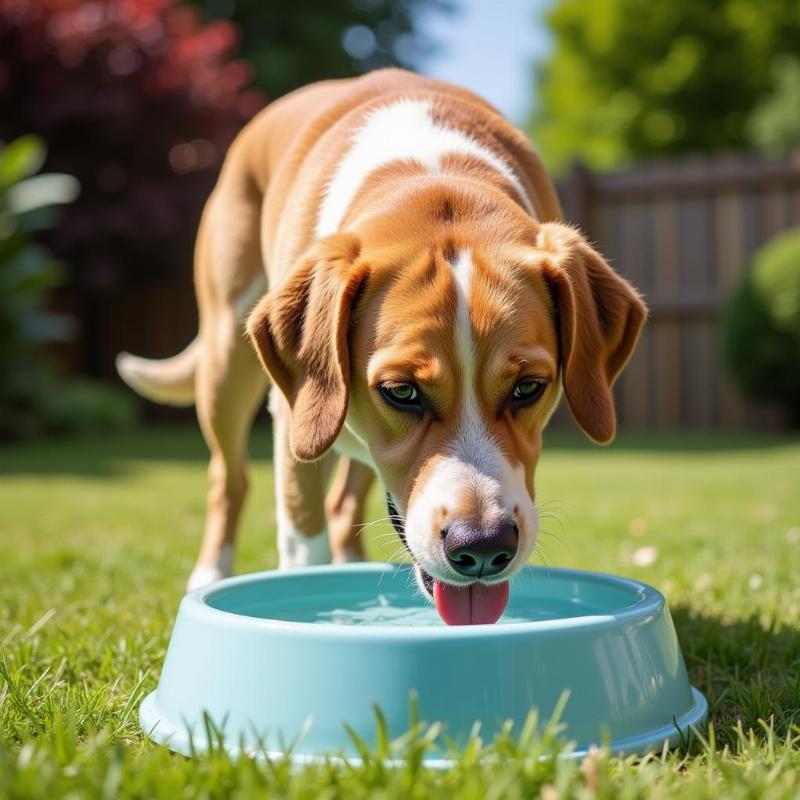Dogs absolutely know when it’s too hot outside, although they might not express it in the same way humans do. While they can’t tell us the temperature in degrees, they demonstrate their discomfort through behavioral changes and physical signs. Understanding how dogs perceive and react to heat is crucial for responsible pet ownership in the US, especially during warmer months. Ignoring these signs can lead to heatstroke, a serious and potentially fatal condition.
Recognizing Your Dog’s Heat Signals
Dogs rely on different mechanisms to regulate their body temperature compared to humans. Panting is their primary method of cooling down, evaporating moisture from their tongues and lungs. They also dissipate heat through their paw pads and by seeking cooler surfaces. Observe your dog closely for these telltale signs that they’re feeling the heat:
- Excessive panting: While panting is normal, heavy, rapid panting, especially accompanied by drooling, indicates overheating.
- Restlessness and pacing: Your dog might struggle to settle down and find a comfortable position.
- Lethargy and weakness: As heatstroke sets in, dogs become increasingly weak and might collapse.
- Bright red gums and tongue: This is a warning sign of elevated body temperature.
- Vomiting and diarrhea: These are serious indicators of heatstroke and require immediate veterinary attention.
- Thick, ropey saliva: Dehydration and overheating cause saliva to become thick and sticky.
How Dogs Experience Heat Differently
Dogs experience heat differently than humans due to their physiology. They have a fur coat, even single-coated breeds, which acts as insulation, trapping heat. They also don’t sweat as efficiently as humans, relying primarily on panting. Certain breeds, particularly brachycephalic breeds like Bulldogs and French Bulldogs, are even more susceptible to heatstroke due to their short noses and restricted airways. Elderly dogs, puppies, and dogs with underlying health conditions are also at higher risk.
Protecting Your Dog from Excessive Heat
Taking proactive steps to protect your dog from excessive heat is essential for responsible pet ownership in the US. Here are some crucial tips:
- Limit outdoor activities during the hottest parts of the day: Exercise your dog early in the morning or late in the evening when temperatures are cooler.
- Provide ample shade and fresh water: Ensure your dog always has access to a shaded area and a plentiful supply of cool, clean water.
- Never leave your dog in a parked car: Even on a mildly warm day, temperatures inside a parked car can quickly soar to dangerous levels.
- Consider using cooling products: Cooling mats, vests, and bandanas can help regulate your dog’s body temperature.
- Learn to recognize signs of heatstroke: Early intervention is crucial for treating heatstroke effectively.
 Dog drinking water in hot weather
Dog drinking water in hot weather
What to Do if You Suspect Heatstroke
If you suspect your dog is suffering from heatstroke, immediate action is vital. Move your dog to a cool, shaded area and apply cool (not cold) water to their body, focusing on the paws and groin area. Offer small amounts of cool water to drink and seek immediate veterinary attention. Heatstroke is a life-threatening emergency and requires prompt professional care. Do not delay seeking veterinary help, as every minute counts.
Conclusion
Do dogs know when it’s too hot outside? Absolutely. By understanding how dogs experience heat and recognizing the signs of heat distress, you can take proactive steps to protect your furry friend from the dangers of excessive heat. Prioritizing your dog’s well-being during warmer months is a cornerstone of responsible pet ownership in the US. Remember, prevention is always better than cure, especially when it comes to heatstroke.
FAQ
- How can I tell if my dog is overheating? Look for excessive panting, restlessness, lethargy, bright red gums, vomiting, and thick saliva.
- What is the most dangerous thing to do with a dog on a hot day? Leaving your dog in a parked car is extremely dangerous and can be fatal.
- What breeds are most susceptible to heatstroke? Brachycephalic breeds like Bulldogs and French Bulldogs are particularly vulnerable.
- What should I do if my dog shows signs of heatstroke? Immediately move your dog to a cool area, apply cool water, offer small amounts of water to drink, and seek immediate veterinary care.
- How can I prevent my dog from overheating in the summer? Limit outdoor activities during the hottest parts of the day, provide ample shade and water, and consider using cooling products.
Related Articles
Beautdogs.us is your premier online destination for all things dog-related in the US. We provide expert advice on dog care, breed information, and a curated selection of products. Whether you’re a new dog owner or a seasoned enthusiast, Beautdogs.us is your trusted source for comprehensive and engaging information. Contact us for all your dog-related needs at [email protected] or call us at +1 501-555-7529. Visit Beautdogs.us today!